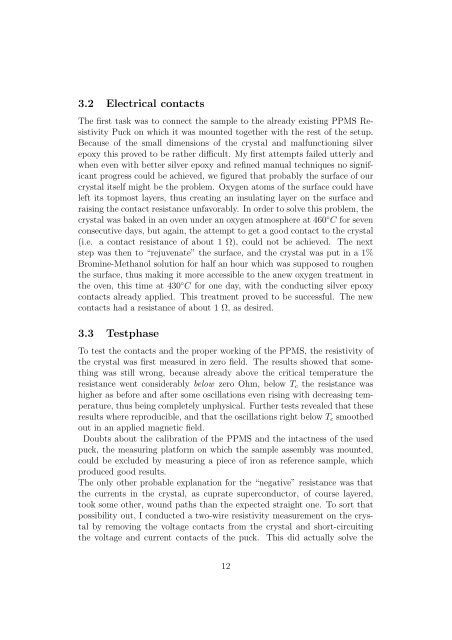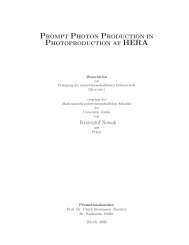Master Thesis Effect of vortex shaking on the ... - Physik-Institut
Master Thesis Effect of vortex shaking on the ... - Physik-Institut
Master Thesis Effect of vortex shaking on the ... - Physik-Institut
Create successful ePaper yourself
Turn your PDF publications into a flip-book with our unique Google optimized e-Paper software.
3.2 Electrical c<strong>on</strong>tacts<br />
The first task was to c<strong>on</strong>nect <strong>the</strong> sample to <strong>the</strong> already existing PPMS Resistivity<br />
Puck <strong>on</strong> which it was mounted toge<strong>the</strong>r with <strong>the</strong> rest <str<strong>on</strong>g>of</str<strong>on</strong>g> <strong>the</strong> setup.<br />
Because <str<strong>on</strong>g>of</str<strong>on</strong>g> <strong>the</strong> small dimensi<strong>on</strong>s <str<strong>on</strong>g>of</str<strong>on</strong>g> <strong>the</strong> crystal and malfuncti<strong>on</strong>ing silver<br />
epoxy this proved to be ra<strong>the</strong>r difficult. My first attempts failed utterly and<br />
when even with better silver epoxy and refined manual techniques no significant<br />
progress could be achieved, we figured that probably <strong>the</strong> surface <str<strong>on</strong>g>of</str<strong>on</strong>g> our<br />
crystal itself might be <strong>the</strong> problem. Oxygen atoms <str<strong>on</strong>g>of</str<strong>on</strong>g> <strong>the</strong> surface could have<br />
left its topmost layers, thus creating an insulating layer <strong>on</strong> <strong>the</strong> surface and<br />
raising <strong>the</strong> c<strong>on</strong>tact resistance unfavorably. In order to solve this problem, <strong>the</strong><br />
crystal was baked in an oven under an oxygen atmosphere at 460 ◦ C for seven<br />
c<strong>on</strong>secutive days, but again, <strong>the</strong> attempt to get a good c<strong>on</strong>tact to <strong>the</strong> crystal<br />
(i.e. a c<strong>on</strong>tact resistance <str<strong>on</strong>g>of</str<strong>on</strong>g> about 1 Ω), could not be achieved. The next<br />
step was <strong>the</strong>n to “rejuvenate” <strong>the</strong> surface, and <strong>the</strong> crystal was put in a 1%<br />
Bromine-Methanol soluti<strong>on</strong> for half an hour which was supposed to roughen<br />
<strong>the</strong> surface, thus making it more accessible to <strong>the</strong> anew oxygen treatment in<br />
<strong>the</strong> oven, this time at 430 ◦ C for <strong>on</strong>e day, with <strong>the</strong> c<strong>on</strong>ducting silver epoxy<br />
c<strong>on</strong>tacts already applied. This treatment proved to be successful. The new<br />
c<strong>on</strong>tacts had a resistance <str<strong>on</strong>g>of</str<strong>on</strong>g> about 1 Ω, as desired.<br />
3.3 Testphase<br />
To test <strong>the</strong> c<strong>on</strong>tacts and <strong>the</strong> proper working <str<strong>on</strong>g>of</str<strong>on</strong>g> <strong>the</strong> PPMS, <strong>the</strong> resistivity <str<strong>on</strong>g>of</str<strong>on</strong>g><br />
<strong>the</strong> crystal was first measured in zero field. The results showed that something<br />
was still wr<strong>on</strong>g, because already above <strong>the</strong> critical temperature <strong>the</strong><br />
resistance went c<strong>on</strong>siderably below zero Ohm, below T c <strong>the</strong> resistance was<br />
higher as before and after some oscillati<strong>on</strong>s even rising with decreasing temperature,<br />
thus being completely unphysical. Fur<strong>the</strong>r tests revealed that <strong>the</strong>se<br />
results where reproducible, and that <strong>the</strong> oscillati<strong>on</strong>s right below T c smoo<strong>the</strong>d<br />
out in an applied magnetic field.<br />
Doubts about <strong>the</strong> calibrati<strong>on</strong> <str<strong>on</strong>g>of</str<strong>on</strong>g> <strong>the</strong> PPMS and <strong>the</strong> intactness <str<strong>on</strong>g>of</str<strong>on</strong>g> <strong>the</strong> used<br />
puck, <strong>the</strong> measuring platform <strong>on</strong> which <strong>the</strong> sample assembly was mounted,<br />
could be excluded by measuring a piece <str<strong>on</strong>g>of</str<strong>on</strong>g> ir<strong>on</strong> as reference sample, which<br />
produced good results.<br />
The <strong>on</strong>ly o<strong>the</strong>r probable explanati<strong>on</strong> for <strong>the</strong> “negative” resistance was that<br />
<strong>the</strong> currents in <strong>the</strong> crystal, as cuprate superc<strong>on</strong>ductor, <str<strong>on</strong>g>of</str<strong>on</strong>g> course layered,<br />
took some o<strong>the</strong>r, wound paths than <strong>the</strong> expected straight <strong>on</strong>e. To sort that<br />
possibility out, I c<strong>on</strong>ducted a two-wire resistivity measurement <strong>on</strong> <strong>the</strong> crystal<br />
by removing <strong>the</strong> voltage c<strong>on</strong>tacts from <strong>the</strong> crystal and short-circuiting<br />
<strong>the</strong> voltage and current c<strong>on</strong>tacts <str<strong>on</strong>g>of</str<strong>on</strong>g> <strong>the</strong> puck. This did actually solve <strong>the</strong><br />
12
















